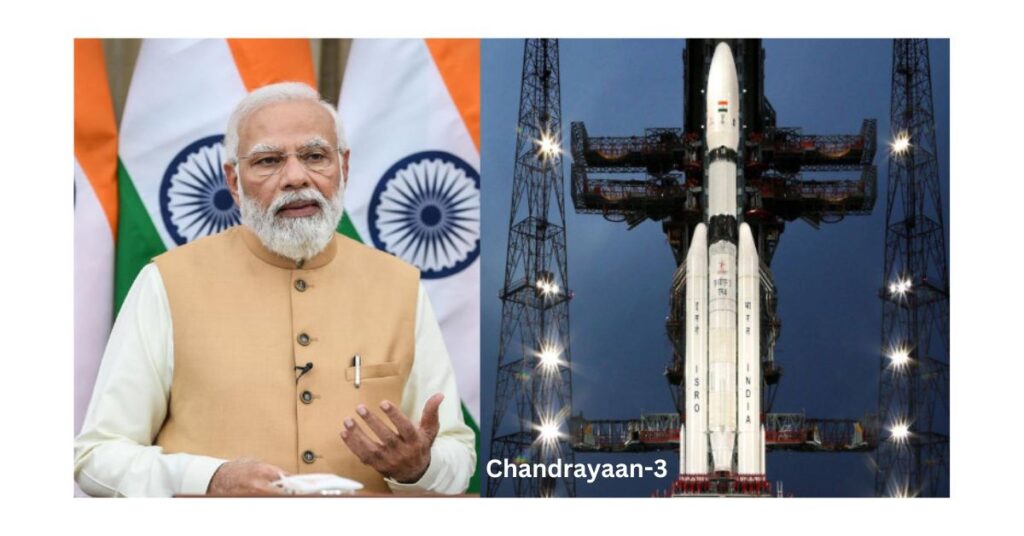India’s Historic Achievement: Chandrayaan-3 Mission Successfully Lands on the Moon for the Third Time

India makes its third lunar landing, and the Chandrayaan-3 mission is successful.
Introduction
With the Chandrayaan-3 mission’s third successful moon landing, India has once again established a name in space exploration. This outstanding accomplishment demonstrates India’s expanding skill and dedication to space research. We shall examine the mission’s specifics, its importance, and the difficulties overcame to make it a resounding success in this post.
Chandrayaan-3 Mission: Opening Up New Horizons
India wanted to learn more about the moon’s surface, its makeup, and the possibilities for future lunar exploration with the Chandrayaan-3 mission. In order to accomplish its goals, the mission—a joint venture between the Indian Space Research Organisation (ISRO) and other foreign partners—combined cutting-edge technology and scientific know-how.

See also on Youtube : https://youtu.be/GdOV6Paw_aU
Goals of the Chandrayaan-3 Mission
The Chandrayaan-3 mission’s primary goals included the following:
1. Examine the lunar surface: Chandrayaan-3 was designed to gather important information about the lunar surface’s geology, topography, and mineral makeup. This knowledge would advance our comprehension of the genesis and development of the moon.
2. Examine the presence of water: One of the main goals was to look for water ice in the areas of the moon that were always in shadow. For upcoming manned missions and space exploration efforts, finding water on the moon would have important ramifications.
3. Showcasing technological developments: The mission included cutting-edge equipment and technology to improve engineering and scientific research capabilities. This expert demonstration highlighted India’s advancements in the field of space exploration.
Overcoming Obstacles
There were many difficulties with the Chandrayaan-3 mission, including:
1. Accurate landing: Landing on the moon’s surface with accuracy is a difficult task. For the mission to successfully land, it needed to be carefully planned and carried out.
2. Lunar environment: The project had technical difficulties due to the hostile lunar environment, which is characterised by extremely high temperatures and vacuum conditions. To endure these circumstances and continue to operate at their peak levels, specialised equipment and devices were created.
3. Navigation and communication: Two key components of the mission were maintaining contact with the lunar lander and orbiter as well as precisely manoeuvring the spacecraft. Strong systems were put in place to deal with these problems.
Investigating the Moon’s Surface
The successful landing of Chandrayaan-3 made it possible to thoroughly explore the lunar surface. To gather important data and carry out investigations, the expedition deployed a variety of instruments and equipment. Let’s examine some of the mission’s major elements and experiments in more detail:
1. Lunar Rover: Exposing the Secrets of the Moon
In the course of the Chandrayaan-3 mission, a highly developed lunar rover was sent into space. The rover travelled across the surface of the moon while collecting samples and running experiments with cutting-edge equipment. It gave useful information about the geology, geophysics, and other scientific features of the moon.
2. Demonstration Analysis: Lunar Mysteries
An onboard laboratory on the lunar rover was used to analyse samples that were obtained. Researchers and scientists looked for signs of water and other elements in the soil and rocks of the moon. This research increased our understanding of celestial bodies and gave vital information for upcoming lunar expeditions.
3. Imaging Systems: Detailed Moon Visualisation
The Chandrayaan-3 spacecraft’s high-resolution photography equipment took precise pictures of the lunar surface. These photos allowed researchers to map geological characteristics, locate potential landing locations for future expeditions, and examine the surface of the moon. The information acquired improved our comprehension of the geological and forming processes of the moon.
Frequently Asked Questions (FAQs)
Q: How many times has India made a lunar landing?
A: The Chandrayaan-3 mission was the most recent of India’s three successful moon landings.
Q: What role does the Chandrayaan-3 mission play?
A: The Chandrayaan-3 project advances our knowledge of the moon’s surface, aids in the development of future space exploration strategies, and highlights Indian technological breakthroughs.
Q: What obstacles have to be overcome for the Chandrayaan-3 mission?
A: The project had difficulties with the lunar environment, landing precision, and preserving communication and navigation in space.
Q: What was the mission’s goal for Chandrayaan-3?
A: The goals included researching the presence of water on the lunar surface and showcasing technological breakthroughs.
Q: What tests were carried out throughout the mission?
A lunar rover was deployed for surface investigation, samples were analysed to unlock lunar riddles, and high-resolution imaging equipment were used for precise mapping.
Q: How does the Chandrayaan-3 mission advance planetary exploration in the future?
A: The mission’s discoveries and technological developments provide the framework for manned lunar missions and other future scientific research projects.
Conclusion Another significant accomplishment for India’s space exploration efforts is the successful Chandrayaan-3 mission. India has demonstrated its scientific prowess and dedication to furthering our understanding of the cosmos by making a third landing on the moon. The mission’s goals, accomplishments, and data collection help advance lunar exploration in the future and advance understanding of celestial bodies among scientists worldwide.










